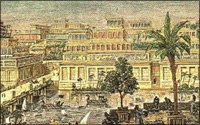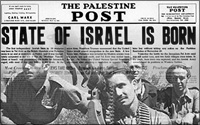 The rise of Islam changed the history of the world and had a profound effect upon the Jewish people. Most of the Jews of that time, in the seventh century, lived in Babylonia and the Land of Israel. Both of those countries were overrun by the Muslims. The Persian-Parthian-Babylonian rulers were all not only dispossessed but converted by the sword to becoming Muslims. The attitude toward the Jews changed. It now became a Muslim attitude.
The rise of Islam changed the history of the world and had a profound effect upon the Jewish people. Most of the Jews of that time, in the seventh century, lived in Babylonia and the Land of Israel. Both of those countries were overrun by the Muslims. The Persian-Parthian-Babylonian rulers were all not only dispossessed but converted by the sword to becoming Muslims. The attitude toward the Jews changed. It now became a Muslim attitude.
The coming of the Muslims to the Jewish populations of the Middle East was and is a mixed blessing. It changed the setup of the Jewish community and serves as an introduction to the period of the Geonim.
The Geonim
The Geonim is the term used to describe the rabbinic leadership in Babylonia — the largest and primary Jewish community in the world. This is a period lasting approximately from the seventh century until the eleventh century (600-1,000 CE), some 400 years.
The word “Gaon” (pl. Geonim) was the title that was conferred upon the head of the academy in Babylon.
From about 200 BCE, i.e. while the Second Temple was still standing in Jerusalem, the Jewish leader in Babylon was called the Reish Galusa (the “Head of the Exile”) or Exilarch. This man was descended from the royalty of the House of David. He was the pretender to the throne of Judea, meaning that if the monarchy would be reinstated and a king taken from the House of David then he would be the king. He was granted temporal powers by Babylonian authorities.
The Jewish community in Babylon existed as an almost-autonomous state. The Jews had their own police force, taxation powers, legislature (to a certain extent), court system, education system, etc. Furthermore, Jews were very influential in commerce, trading and shipping. Consequently, the Exilarch wielded a great deal of power, including the important governmental powers of patronage, punishment and taxation. Therefore, this position was never free from what we euphemistically call “politics.” It was never free from controversy and difficulties.
Moreover, in order for the position to work it required an almost superhuman individual. An ordinary person would be broken by the job because of the conflicting demands and pressures. The Jewish people were fortunate enough that at least half the time – perhaps 70% of the time – they had such super-people. Under their leadership, the Jewish community prospered and was able to keep at bay the pagan authorities at the same time controlling internal divisions within the community.
However, the 30-40% of the time when the Reish Galusa was ordinary or even merely better-than-average there were problems. Those problems were usually the result of the fact that the Jewish community had a parallel government to the Exilarch: the Gaon, who was the religious head of the community.
On paper, this division was perfect. One office was in charge of the religious life of the people while the other was in charge of temporal affairs. Of course, as we know the division is not so simple; the two overlap in many ways. It is sometimes difficult to draw the line and say here is where religious life ends and mercantile life begins. It is hard to distinguish between political and theological.
Therefore, in order for the overall system to work the Gaon also had to be a super-person. It went without saying that he needed superior Torah knowledge, but he had to be a super-person in terms of personality, character, tolerance, cleverness, etc. Most of the time, he had those qualities. And most of the time, the Gaon and the Reish Galusa were able to govern together and effectively share the division of power. However, approximately a third of the time they could not and a virtual civil war ensued.
These problems came to the fore with the arrival of the Muslims.
The Karaites
A major event at the beginning of the Geonic era was the rise of a new sect among the Jewish people, the Karaites.
The Karaites were a deviant sect who broke off from the main tradition of Judaism, denied the authenticity of the Oral Law and rejected all the rabbinic laws that the Talmud represented. They were not only non-Talmudic, but anti-Talmudic. They were heir, at least in spirit, to the ideas of the Sadducees, who existed in the time of the Second Temple.
They were founded by a man named Anan, a common name in Jewish Babylonia. He was descended from the House of David and a nephew of one of the Exilarchs. When his uncle died childless he felt that by right of inheritance — and by an ego that led him to think that he was the greatest scholar and leader — he was entitled to become the Exilarch.
Now, part of the baggage of Arab civilization was corruption. Not just corruption as we know it but as an accepted way of life. If a person wanted to get something done he had to pay off someone. Today there are countries where if a person wants to go to the post office to buy a stamp he has to leave a tip for the postal clerk. Until you give the “tip” the clerk does not see you. It does not matter that he is a government functionary and that he is allegedly being paid to sell you postal stamps.
That is a way of life, a part of the culture of this type of civilization. In later times, at the turn of the twentieth century, Herzl wrote in his memoirs about his visit to the Sultan of Turkey to try to buy Palestine from the Turks. The Sultan always welcomed the opportunity for more money and was willing to hear the offer. Herzl wrote that he spent more than $50,000 in “tips” at the court of the Sultan during the times of his appointments.
That was the “system” in the eighth century also. If one wanted to be appointed the Exilarch one had to pay good money. Anan either was not astute enough or wealthy enough, but he did not get the appointment. The other person got it by paying for it. This system, of course, does not guarantee that the best candidate will be chosen.
As a result, Anan was very bitter.
After his failure to achieve the position of Exilarch he wanted to be appointed the Gaon, who was generally the head of the greatest academy. This position was not for sale, however. One could not acquire it by paying off someone. It was based on merit and scholarship. Even though Anan was a scholar of note, he was not equal in scholarship to the other candidates. Therefore, he was rejected for this position as well.
Furthermore, he had employed the tactics of those seeking the position of Exilarch: he tried to pay off – to corrupt – the electors so that they place him as head of the academy. That was a mistake. They felt cheapened and insulted that someone would even attempt to do that. Consequently, Anan not only lost any chance he had for the position but was outright rejected. That, in turn, made him an even bitterer person.
The Limitations of Literalism
As a result, he made up his own religion – where he could be both the “Exilarch” and the “Gaon.” He remade Judaism in his own image and called it Karaism, a variation of the Hebrew word mikra, “word” or “scripture,” claiming he was only bound by the literal translation of the Five Books of Moses. Later, he included the Book of Joshua as well. The rest of the Bible, as well as the Talmud, were invented by the rabbis, he claimed. He called his enemy, “Rabbinic Judaism.”
It does not take much time and thought to deduce that one cannot deal with any book literally, let alone the Five Books of Moses. There has to be some explanation. For example, it says, “And you shall bind them upon your arms and they be upon your head.” What are “they”? How do “they” look? The Oral Tradition explains that “they” refer to tefillin, the black leather boxes with the black straps that Jews place on their arms and heads every weekday.
Anan, in fact, adopted many of the elements of “Rabbinic Judaism.” He was forced to. The literal translation did not lend itself to an obvious explanation. Therefore, in effect, he wrote his own Talmud, his own Oral Law. In some ways, his interpretation was stricter than the rabbinic laws of Judaism. For instance, in the Torah it says, “Let no man go out from his place on the Sabbath.” According to the Oral Law it means that there is a maximum amount of distance a person can walk in an open area on the Sabbath. Anan’s interpretation was that one could not go out of his house! Those that were fanatical followers of his did not get off of their chairs on the Sabbath!
In the Torah it says, “On the Sabbath, you shall not burn a fire anywhere in your dwelling places.” The Oral Law understood that as it being forbidden to turn on a fire. However, if the fire existed before the Sabbath, then it is not only permitted but the light and warmth from it was necessary in order to enjoy the Sabbath. The Karaites said it was forbidden to have a fire at all. That was the literal translation, according to them. Therefore, on a Karaite Sabbath everyone sat in a cold, dark house and ate only cold foods.
In other areas of Jewish law, they discarded prohibitions that the rabbis had constructed to try to protect the Jewish home. Therefore, on one hand, Karaism was stricter than Rabbinic Judaism. On the other hand, including many important areas, it was far more lenient.
At its height, the Karaites could probably claim some 500,000 Jews. They spread greatly the first 50 years. However, like all ideas outside the scope of Judaism the Karaite movement did not stand the test of time. Most Karaites would eventually convert and become Muslims. It became a conduit out of the Jewish people – just as, unfortunately, other types of schisms in the Western world of Judaism did in the 18th and 19th centuries. There, instead of a conduit into Islam they were conduits into Christianity. But the basic pattern was the same: it proved to be a conduit out.
Today, there are approximately 300 Karaite families left, almost all of whom live in a couple of villages in Israel. In Eastern Europe there were Karaite villages that had lasted centuries. But Hitler voted that they were Jews and annihilated them. Indeed, after the time of Rabbi Saadiah Gaon the rabbis decided that there were to be treated as Jews. Nevertheless, they never again posed a threat to mainstream Judaism. They remained an anachronism.
The initial success of the Karate movement shaped the attitude of the Geonim and the Jewish people toward its own internal struggle.











